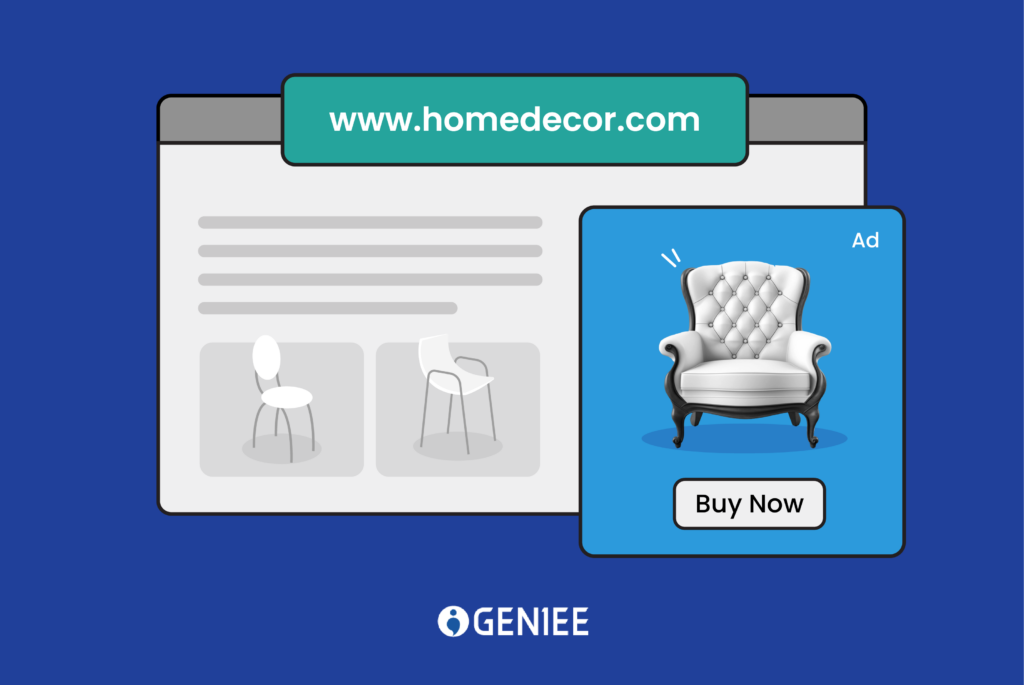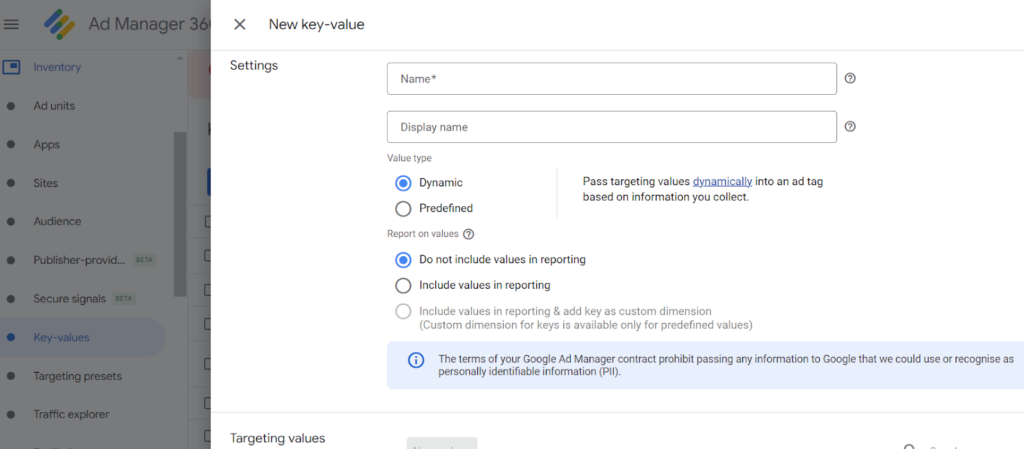
| Concerned about the disconnect between your website content and the ads in the inventories causing early page abandonment? Consider implementing contextual targeting. This technique can help address this issue and improve your website’s performance. |
Imagine that you are a publisher having a blog about home improvement. You have just written a post about DIY backyard landscaping. As readers engage with your content, they notice ads for gardening tools and outdoor furniture seamlessly integrated within your blog. These ads perfectly complement your content, offering readers products relevant to their interests.
This scenario can be regarded as illustrating contextual targeting. Recently, many publishers have been eager to have their ads displayed using this mechanism. Contextual targeting is expected to further evolve as predictions about the demise of cookies – ads displayed based on users’ web browsing history – come to fruition.
In addition, a study from Statista indicates that contextual targeting is predicted to grow significantly at nearly 14% annually from 2022 to 2030.
The following blog will help publishers gain a thorough understanding of contextual targeting and how it operates.
What is Contextual Targeting?
Contextual targeting is a mechanism for presenting advertisements on websites or apps that are relevant and aligned with the content on those pages. Through contextual targeting, it helps reach the right target audience at the moment publishers want to display the ads.
This approach requires an understanding of the audience’s interests and the relationship between the advertisement and the page that display ad to maximize user interaction.
To illustrate, consider the following example. A website that focuses on technology utilizing contextual targeting will leverage the algorithm to display ads that incorporate the theme. Whether it’s a video, image, or article, they will be customized to fit the context of the page.
For instance, a post in the tech news section may include an advertisement for a release of a foldable smartphone. Consequently, those interested in technology news will be more likely to engage with this product rather than unrelated ads randomly placed (such as cosmetics, pharmaceuticals, household items, etc.).
Using an ad network, specific criteria such as main content and keywords will be utilized for advertising segmentation. Ultimately, your ads will appear on web pages or sections with content related to the services or products you offer.
How Does Contextual Targeting Work?
If you’re curious about how a website can display ads perfectly aligned with the content of the page, here’s a step-by-step process of how contextual targeting operates:

Step 1: Content Examination
Firstly, data from websites is collected to meticulously examine the content where the ad will be displayed to users. Web crawlers analyze various elements on the page to classify including text, images, etc,.
Step 2: Keyword Relevance
Next, natural language processing and machine learning algorithms identify the themes, keywords, and phrases within the page content that align with the advertisement. This involves understanding the meaning and context of the content to serve the next step.
Step 3: Advertisement Placement
After categorizing and determining suitable keywords/topics, the advertising platform selects relevant ads to display.
Step 4: User Engagement
As users access the website and interact with the content (e.g., reading, watching, playing), contextual ads are displayed alongside. Naturally, users are more likely to notice and find these ads appealing compared to randomly displayed ones.
Based on research conducted by Silverpush, nearly 70% of consumers show greater engagement with content that is contextually relevant.
Step 5: Ad Click-Through
When users find the ads compelling, they click on them to learn more or make a purchase. Each click incurs a charge (CTR).
Step 6: Optimization
Finally, the ad groups can be continuously updated and evaluated the effectiveness of contextual ads to adjust keywords, content, frequency, and timing as needed to maximize relevance and click-through rates.
5 Attractive Benefits of Contextual Targeting You Should Know
Contextual targeting offers numerous advantages worth discussing. Presented below are some of the primary benefits of using contextual targeting.
Cookie-less Advertising
In contrast to behavioural targeting, contextual targeting displays ads entirely without relying on cookies. This method helps adhere more easily to the strict data protection laws like GDPR (General Data Protection Regulation). Users do not necessarily have to consent to cookie collection when accessing the web but can still observe relevant ads. Additionally, it aids in reducing legal scrutiny in countries with stringent regulations regarding user data.
Avoids Banner Blindness
Contextual targeting helps publishers minimize banner blindness by displaying ads that are relevant to the content on the page. Banner blindness is a common phenomenon where users unconsciously ignore or overlook online banner advertisements due to their frequent exposure. By utilizing contextual targeting, users are more likely to notice and engage with these ads. There is also a result from a GumGum study indicating that advertisements demonstrating the highest level of contextual relevance resulted in a 43% increase in neural engagement and 2.2 times greater ad recall compared to other ad display techniques.
Personalized Ad Experience
A research from Epsilon suggested that customers tend to interact more with personalized products and experiences, including digital advertisements. This marketing approach can lead to higher engagement, conversion rates, and revenue. And contextual targeting is one of the ways to personalize ads. However, it should be noted that this is not the only strategy, as there are other methods to provide customers with personalized experiences.
Increases Click-through Rate
When users encounter ads related to the topics they are reading or interacting with on the page, they are naturally more inclined to click on them to learn more. As a result, the click-through rate increases and ad viewability also improves.
Cost-Effectiveness and Minimal Advertisement
When compared to traditional advertising, contextual ads naturally offer cost savings because advertisers only need to pay for each click (CPC) rather than per impression (CPM). Additionally, a tailored message corresponding to the page is presented to cleverly capture the audience’s attention.
How to Run Contextual Targeting in Google platforms?
Depending on the platform that the publishers choose, there are different ways to target ads contextually. Let’s take a look at how two of Google’s most popular advertising platforms handle this:
Google AdSense
In fact, the publishers employing Google AdSense already leverage its integrated contextual targeting feature because this platform utilises keywords and keyphrases present on a webpage to match relevant ads for users.
Google Ad Manager
Since contextual targeting is not pre-installed in Google Ad Manager, the publishers need to set it up themselves by adding key-values. Key values are customizable features tailored to specific requirements such as pages, inventories, etc. And contextual targeting is a part of it, though you can use various other targeting types.
Here are the specific steps to add key-values:

Step 1: Navigate to the Inventory section on Google Ad Manager homepage left side, then select Key-values followed by New Key-value.
Step 2: Provide a Name and a Display Name for your new key-value.
Step 3: Choose a Value Type from the options provided: Dynamic or Pre-defined.
Step 4: Access the Report on Values section. Choose Yes if you want these keys to be reportable.
Step 5: Proceed to the Targeting Values section and select New Values to add values based on your preferences. We can add multiple values as required.
Step 6: Finally, don’t forget to click on Save to complete the process.
The next step depends on your goal, and you can choose one of two types of targeting: ad slot-level or page-level.
For ad slot-level targeting, it’s recommended to set up for specific targeting of a particular audience. The set Targeting() function can be used to allocate key-values to specific ad slots.
On the other hand, for page-level targeting, this method is more suitable for broader targeting, such as targeting the entire website. Publishers can implement page-level targeting by using googletag.pubads().setTargeting.
What Is the Difference Between Contextual Targeting and Behavioral Targeting?
A common misconception arises when people have the tendency to confuse contextual targeting with behavioral targeting. Despite both being forms of targeted advertising, contextual and behavioral targeting exhibit distinct differences.
Many publishers wonder which targeting method is the perfect fit, but it actually depends on your specific goals. Read the following comparison chart to find the answer:
| Aspect | Contextual Targeting | Behavioral Targeting |
|---|---|---|
| Basis | Immediate context of content being viewed | Tracking past user behavior and/or browsing history |
| Approach | Delivers ads based on current website’s content | Predicts future behavior based on past actions |
| Privacy | Generally less invasive, as it does not track users and use their browsing history | Raises privacy concerns due to tracking user activity and using cookie |
| Flexibility | More adaptable to changes in user interests or content | Less adaptable to adapt to changes in user behavior |
| Audience | Performs well with audience segmentation and specialized websites | Performs on any type of website and its specific topic |
Conclusion
Indeed, contextual targeting serves as a powerful tool for supply sides. By tailoring advertisements to fit the context of the web page, we can enhance the engagement opportunities with target audiences. The flexible approach of contextual ads, spanning from news websites to even gaming platforms, has facilitated user outreach through relevant advertising. Furthermore, respecting user data privacy is a cornerstone that contextual ads can uphold in the era of the third-party cookie apocalypse.
Frequently asked questions
1. Do contextual advertising have any disadvantages?
Yes, they do. Some notable drawbacks of contextual ads include the potential for user discomfort if they obscure or interrupt the main content. Additionally, they face high competition as the ads are often placed alongside or at the same time with others from competitors in the same industry.
2. What is the future of contextual advertising?
Contextual advertising appears as a flexible solution, able to navigate the intricacies of the digital advertising ecosystem with integrity and efficacy, in this dynamic landscape where consumer preferences continuously shape advertising practices and privacy concerns are of the highest priority.
3. Can we combine contextual targeting with other targeting methods?
Combining contextual targeting with other targeting methods can bring better results by enhancing the precision and relevance of your advertising campaigns. For instance, integrating contextual targeting with behavioral targeting together enables you to target users based on their interests and browsing behaviors while ensuring that your ads are contextually relevant to the content they are viewing.

0 Comments